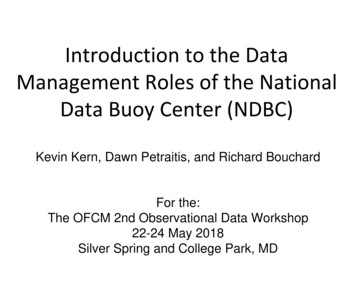
Transcription
Introduction to the DataManagement Roles of the NationalData Buoy Center (NDBC)Kevin Kern, Dawn Petraitis, and Richard BouchardFor the:The OFCM 2nd Observational Data Workshop22-24 May 2018Silver Spring and College Park, MD
NDBCOur VisionA sustainable and resilient marine observation and monitoringinfrastructure which enhances healthy ecosystems,communities, and economies in the face of change.Our MissionTo provide quality observations in the marine environment in asafe and sustainable manner to support the understanding ofand predictions to changes in weather, climate, oceans andcoast.
NDBC
NDBC Organization
Quality Control NDBC performs– automated QC prior to release to GTS– manual QC prior to archive at NCEISee NDBC Handbook of Automated Data Quality ControlChecks and AutomatedDataQualityControl2009.pdf
NDBC currently releases the following data to the GTSvia the NWSTG: Weather Buoy Data: FM13 SHIP (provide wind and swell waves), FM65 forspectral wave dataC-MAN: Form of FM12Tropical Atmosphere-Ocean Array (TAO): BUFR Moored Buoy and FM18DART (Tsunami): DART-specific formatGlider (IOOS DAC, UW, Navy): BUFR ARGO Float Template and FM64TESACADCP Data (Partners): FM64 TESACIOOS: FM12 (C-MAN type stations), FM13, FM64, FM65Scottish Association for Marine Science (SAMS) Data: FM14Ice Tethered Profiler (ITP) Data (WHOI): FM64NOAA Vessel CTD casts Gulf of Mexico (NOAA Southeast Fisheries): FM64TESAC (probable transition to future OMAO/NCEI pathway)US Naval Academy/USAFR 53rd Weather Squadron: Airborne ExpendableBathy Thermographs (AXBT): FM63 BATHYNDBC also provides HFRadar data to NWSTG (currently used byNowCoast): GRIB and raw radial files
NDBC’s WMO/GTS Activities NDBC currently handles the assignment for U.S.A: WMO Station Identifiers for Moored buoys, Drifting buoys, Argo Floats,Gliders and Subsurface Profiling Coastal Automated Meteorological Stations (NWS/NDBC C-MAN, NOSNWLON, etc) using NWS Location Identifiers NDBC serves as the IOOS gateway to the GTS WIGOS Task Team on Metadata JCOMM (Joint Commission WMO/IOC): Data Buoy Cooperation Panel (DBCP) DBCP Task Team on Data Management Task Team on Wave Measurement and Testing International Tsunami Partnership (ITP) WMO Task Team – Moored Buoys WMO Region IV Regional Marine Instrumentation Centre (RMIC)
NDBC BUFR Migration NDBC is currently targeting the end of July/August to release BUFR NDBC plans to dual release in both BUFR and TAC for a transition period (TBD) The planned headers are detailed in the following slide For Buoys & C-MAN, NDBC will be using the Moored Buoy Template 315008 315008 accommodates FM64 TESAC and FM65 WAVEOB For subsurface profiling gliders: BUFR ARGO Float Template & FM64 TESAC Transitioning FM64 TESAC to BUFR ARGO Float Only BUFR ARGO Float “creative” acceptable to OPCs so far Status of development of glider WMO BUFR Template? NDBC will work with NCEP to stop the BMT release of our data upon release (preliminarydiscussions have occurred) The DART/Tsunami data will not be included in the initial release Some issues with the BUFR template: DART II specific; new generation DART or nonDART systems (e.g., India, MSM (Ecuador & Colombia), Sonardyne) Will continue with DART-specific format until BUFR template more flexible Future work to include full support of the 7-digit WMO id’s within all NDBC systems
Top 3 Ocean Data Challenges BUFR template for Gliders and TsunamiStations WMO Identifier changes/impacts Clarification of WMO/GTS guidance whileplanning (i.e proper headers)
Impact of WIGOS IDs on Navigation Charts?Presently Use 5-digit WMO
For Processing or BUFR issues Contact:Kevin Kern, kevin.kern@noaa.gov, (228) 688-1721For WMO & C-MAN ID Assignments Contact:Dawn Petraitis, dawn.petraitis@noaa.gov, (228) 688-2940For Data Related Questions/Issues ContactNDBC Mission Control Center (MCC)Available 24 x 7228-688-2835DMAC@noaa.gov
DART Template IssuesBackground Slide Rigidly follows the DART II Format All examples are DART II; no generic examples Uses DART II-specific message types: Standard Mode, RandomEvent, and Hourly Event Uses older DART II format from 2007 which was changed in 2010and not documented (added manual trigger messages) The system table does not include MSM, Sonardyne, DART Near-fieldth(4 Gen) Includes parameters not necessary for tsunami detection like batteryvoltage & # attempts to communicate Does not identify type of tsunami detection algorithmth DART Near-field (4 Gen) has changes to the DART-specific format
NDBC currently releases the following data to the GTS via the NWSTG: Weather Buoy Data: FM13 SHIP (provide wind and swell waves), FM65 for spectral wave data C-MAN: Form of FM12 Tropical Atmosphere-Ocean Array (TAO): BUFR Moored Buoy and FM18 DART (Tsunami): DART-specific format Glider (IOOS DAC, UW, Navy): BUFR ARGO Float Template and FM64










